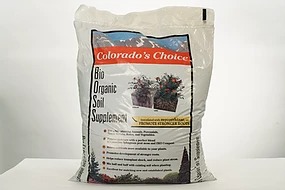 Amend the Soil – Amending the soil with organic material should always be the first step when planting tomatoes. Before you plant, amend your beds with at least one inch of Colorado’s Choice B.O.S.S. or other organic compost. This will help improve the physical structure of your soil and also introduce beneficial organic material. and organisms.
Amend the Soil – Amending the soil with organic material should always be the first step when planting tomatoes. Before you plant, amend your beds with at least one inch of Colorado’s Choice B.O.S.S. or other organic compost. This will help improve the physical structure of your soil and also introduce beneficial organic material. and organisms.
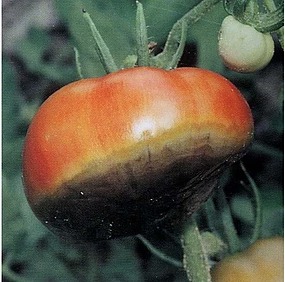
Blossom End Rot – A common tomato problem caused by calcium deficiency. It usually occurs during big changes in temperature or moisture. Keep your tomatoes consistently watered and mulch around the base to hold in moisture. Some gardeners also like to add egg shells or powdered milk when planting to give their plants a boost of calcium.
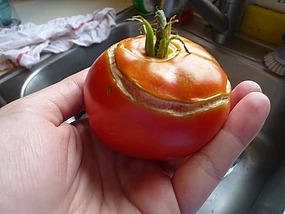
Cracking – Another common tomato problem, cracks are caused by uneven growth. This usually happens when we get a lot of rain followed by a hot, dry period. This forces the tomatoes to grow too fast while the fruit is still ripening, cracking the skin. The best way to prevent cracking is by maintaining even, consistent watering throughout the season. If your tomatoes do crack, they’re still fine to eat. Just slice off the cracked part and enjoy the rest.
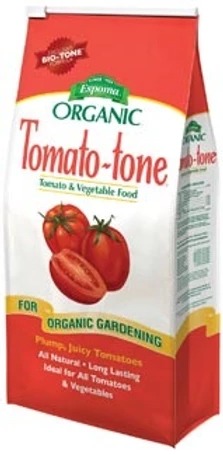
Determinate – Determinate tomatoes grow in compact bushes. All growth stops when flowering begins. All the fruit on a determinate tomato plant will ripen within a week or two of each other, making for a large one-time harvest.
Espoma Tomato Tone – One of the best organic tomato fertilzers out there. It’s specially formulated for tomatoes and contains extra calcium and mychorriaze to help grow strong healthy roots.
Fertilizing – Tomatoes are heavy feeders, so fertilizing should be done every 2 weeks. Use higher nitrogen until mid-June. Use lower nitrogen for the rest of the summer to promote fruit rather than plant growth. Always follow product instructions.
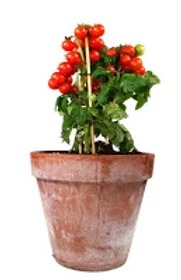
Growing in Pots – Container planting is a great solution for limited space. Most tomato varieties can be used, though smaller tomatoes typically result in greater success. For best results, use pots with a diameter of at least 18″. Remember that all container tomatoes will require more water and fertilizer than those grown in gardens.
Heirloom vs. Hybrid – Heirloom vegetables are old-fashioned varieties that have been handed down, unchanged and un-hybridized, from one generation to the next. Some heirloom plants have been grown the same way for over 100 years. Heirloom seeds are also “open pollinated,” which means they are pollinated by insects, wind or other natural means. Heirloom vegetables are mostly prized for their flavor. Many people will tell you that once you try an heirloom tomato, you’ll never go back to the store bought kind.
Hybrid vegetables are a combination of two or more plants that bring out the best features of their parent plants, like better disease resistance or higher yield. Hybrid tomatoes, it should be stressed, are NOT Genetically Modified Organisms (GMOs). They are hybridized through a natural process of cross-pollination. Hybrid tomatoes often give more reliable, uniform results than heirloom seeds and can be grown organically.
Indeterminate – Indeterminate tomatoes grow on vines that can get very big. The vine keeps growing through the growing season, producing fruit until the first frost. This leads to smaller harvests throughout the season.
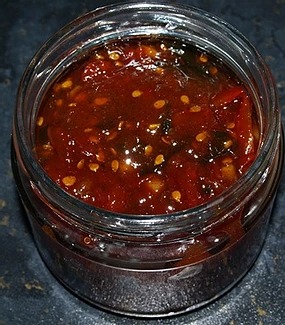
Jam – You’ve had tomato soup, sauce, juice and paste, but have you every had Tomato Jam? It goes great on bread, toast or bagels.
Ingredients
4-5 Tomatoes Grilled (8-10 minutes) until skins split, peeled and chopped
1 Med Granny Smith Apple, peeled, cored and grated
1/4 tsp fresh ground pepper
3/4 tsp. ground ginger
2 tbsp. lemon juice
1 1/2 cups powdered sugar
1 clove garlic, crushed
Directions
1.Combine tomatoes, apple, pepper, ginger and garlic in a microwaveable pan.
2. Microwave for 12 minutes.
3. Add sugar and lemon juice until dissolved.
4. Microwave for 3 minutes and stir.
5. Microwave for 3 minutes and stir.
6. Microwave for 3 minutes and stir.
7. If jam is not thick enough, microwave at 1 minute intervals until ready
Keeping – Tomatoes are one of those foods you should never refrigerate. It spoils the texture and taste of garden fresh tomatoes. It’s best to store tomatoes at room temperature or freeze them. Just core the tomatoes and place them whole in freezer bags. The skins will slip off when they defrost.
Let’s Call the Whole Thing Off – This immortal song by George and Ira Gershwin is beloved by tomato-heads and diction-freaks alike for ably and tunefully demonstrating the two pronunciations of the word “tomato” (“You say ‘to-MAY-to, and I say ‘to-MAH-to’). Both are acceptable, FYI.
Mulch – Mulching around the base of your tomato plants helps to retain moisture, which helps to avoid problems like cracking and blossom end rot. Mulch can also smoother weeds and deter bugs. Check out all the different bark mulch varieties on our website.
Neutral, Alkaline or Base – Tomatoes prefer a slightly acidic soil with a pH level of around 6 to 6.8. You can easily test your soil’s pH with a home soil test kit. Use compost, organic materials and sulfates to improve nutrition and adjust the pH level .
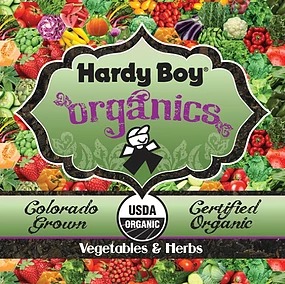
Organic – More and more people are interested in organically grown produce these days. We carry a full line of organic tomatoes and vegetables from Welby Gardens. These plants are grown locally here in the Denver area and are USDA certified organic, which means they are grown with methods that preserve the environment and avoid most synthetic materials, such as pesticides and antibiotics.
Paste – Paste tomatoes take less time to cook down and prefect for making tomato sauce, chili sauce or salsas. The oldest paste tomato is La Roma, but there are other varieties, too. Check out Amish Paste, Hungarian Heart, Red Plum, San Marzano and Viva Italia.
Questions – Got tomato questions? Ask A Gardener is the place for you! Submit your question, and our veggie gurus can help you find the answers. And if we pick your question to feature on our website, you could win a $10 O’Toole’s gift certificate!
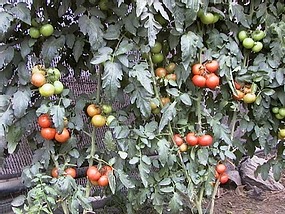
Ripening – Ever wonder why tomatoes turn from green to red as they ripen? Tomatoes get two chemicals from photosynthesis, chlorophyll which turns things green and lycopene that turns things red. As the tomatoes mature, the chlorophyll drains away, leaving the lycopene to take over, giving the tomatoes their reddish hue. It’s a process not dissimilar to the way leaves change in the fall. At the same time, sugar levels increase and the fruit becomes less acidic and softer until the tomato is just perfect to eat. How do you know when your tomato is good and ripe? The Old Farmer’s Almanac describes the perfect tomato for picking as, “firm and very red in color, regardless of size, with perhaps some yellow remaining around the stem. A ripe tomato will be only slightly soft.”
Spacing – Leave about 2 feet between determinate tomatoes and 2 ½ feet between indeterminates. Try to plant at least 2 tomatoes within 4 feet of each other for pollination.

Tomatina – La Tomatina is the largest tomato fight in the world. Though no one is quite sure how the festival started (perhaps a long-forgotten political feud), every August for over 70 years people have flocked to the tiny Spanish town of Buñol to take part in the fight. Over four days, revelers heave some 90,000 pounds of squashed tomatoes at each other. For fun. The strangest part? Buñol doesn’t even grow tomatoes! All the fruit for the festival is imported.
Upside Down Growing – There’s a lot of good reasons people are head over heels for upside down growing – it saves space, it can reduce insects, fungus and disease, there’s more efficient air and water circulation and there’s better light exposure. Plus, it just looks cool! In the video, Laura from Garden Answers shows you how to create your own upside down tomato hanging basket.
Vegetable or Fruit? – Believe it or not, this problem once reached the highest court in the land. In the 19th century vegetables we subject to a 10% import tax, while fruits were tax free. A tomato importer brought a case to the Supreme Court arguing that since tomatoes are actually fruits they should therefore be exempt from the tariff. After wrestling with the existential question, “What makes a fruit a fruit?”, the court finally ruled that while botanically tomatoes are fruits (“an organ that contains seeds, protecting these as they develop and often aiding in their dispersal.”), most people in everyday life consider them vegetables. Under customs law, tomatoes were ruled veggies and the importer had to pay up.
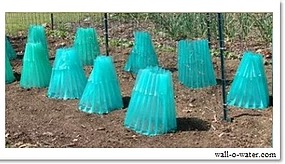
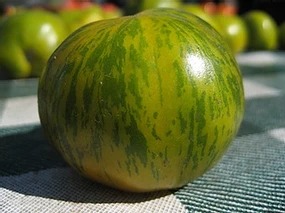
Xitomatil – The word for “tomato” in the Aztec language Nahutil. It loosely translates to “plump thing with a navel.”
Yellow – Red isn’t the only color tomatoes come in. There are also yellow, gold, white, cream, black, purple, pink and orange colored tomatoes.
Zebra – Striped ones, too!
